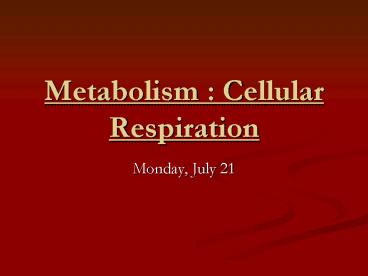Metabolism : Cellular Respiration - PowerPoint PPT Presentation
1 / 34
Title:
Metabolism : Cellular Respiration
Description:
The sum of all the chemical reactions in an organism arranged in branched ... The spinning rod causes conformational changes in the knob which activates ... – PowerPoint PPT presentation
Number of Views:38
Avg rating:3.0/5.0
Title: Metabolism : Cellular Respiration
1
Metabolism Cellular Respiration
- Monday, July 21
2
Metabolism
- The sum of all the chemical reactions in an
organism arranged in branched metabolic pathways
that alter molecules by a series of steps - Catabolic pathways degradative processes
- Release energy by breaking down glucose to H20
and CO2 - Anabolic pathways generative processes
- Consume energy to build proteins from amino acids
3
Figure 9.1 Energy flow and chemical recycling in
ecosystems
4
Cellular Respiration
- Harvesting energy for cellular processes
- Complex organic molecules (glucose) rich in
potential energy ? simpler waste products with
the release of energy - C6H12O6 6O2 ? 6CO2 6H2O ENERGY (ATPheat)
- ?G - 686 kcal / mol glucose (exergonic)
- Process occurs in the mitochondria
ATP adenosine triphosphate
5
Figure 9.2 ATP drives cellular work
6
Oxidation-Reduction Reactionsredox
- Transfer of electrons releases the energy stored
in glucose used to synthesize ATP - Oxidation loss of electrons
- Reduction gain of electrons
- Xe- Y ? X Ye-
- X reducing agent (electron donor)
- Y oxidizing agent (electron acceptor)
Electrons move away from carbon and hydrogen and
closer to oxygen (electronegative), releasing
energy
7
Oxidizing Glucose
reduction
C6H12O6 6O2 ? 6CO2 6H2O
oxidation
The transfer of electrons from glucose to oxygen
occurs in steps through the intermediate coenzyme
NAD (nicotinamide adenine dinucleotide)
2H/2e-
NAD shuttles electrons from glucose to oxygen
8
Energy releasing steps electron transport chain
Least electronegative
Proteins built into the inner mitochondrial
membrane
Most electronegative
?G -53 kcal/mol
9
Figure 9.6 An overview of cellular respiration
anaerobic
10
Figure 9.6 An overview of cellular respiration
aerobic
anaerobic
11
Figure 9.6 An overview of cellular respiration
anaerobic
aerobic
38 ATP
12
Figure 9.7 Substrate-level phosphorylation
Phosphoenol pyruvate
13
Figure 9.8 Glycolysis Energy Transfer
14
Figure 9.9 Glycolysis
G-6-P carries a negative charge so it is trapped
in the cell because the PM is impermeable to ions
15
Figure 9.9 Glycolysis
16
Figure 9.9 Glycolysis
oxidation
17
Figure 9.9 A closer look at glycolysis energy
payoff phase
18
Figure 9.8 Glycolysis Energy Transfer
19
Figure 9.10 Conversion of pyruvate to acetyl
CoA the junction between glycolysis and the
Krebs cycle
Diffuse out of cell
To Krebs cycle
20
Figure 9.11 Krebs cycle
2C
Mitochondrial Matrix
Eight steps 2 carbon Acetyl CoA 4 carbon
Oxaloacetate 6 carbon Citrate Series of steps
break citrate down to oxaloacetate, releasing CO2
and energy is stored as 3 NADH and 1 FADH2 (which
donate their electrons to the ETC)
6C
4C
21
Figure 9.11 Krebs cycle
2C
4C
6C
5C
4C
22
Figure 9.11 Krebs cycle
2C
4C
6C
4C
5C
CoA displaced by a phosphate group
4C
23
Figure 9.11 A closer look at the Krebs cycle
2C
4C
6C
4C
5C
4C
24
Figure 9.12 A summary of the Krebs cycle
3 CO2 4 NADH H 1 FADH2 1 ATP (x2)
25
Figure 9.13 Free-energy change during electron
transport
As each protein accepts an electron, it becomes
reduced. When it passes the electron to the next
protein in the chain (more electronegative), it
returns to its oxidized state.
26
Figure 9.15 Chemiosmosis couples the electron
transport chain to ATP synthesis
The ETC uses the exergonic flow of electrons to
pump H across the membrane
Exergonic flow of H to make ATP
27
Figure 9.14 ATP synthase uses the energy of
the proton gradient to power ATP synthesis
Protons flow down a narrow space in the rotor,
causing the rotor and rod rotate. The spinning
rod causes conformational changes in the knob
which activates catalytic sites that combine ADP
and P.
28
Figure 9.16 Review how each molecule of glucose
yields many ATP molecules during cellular
respiration
NADH 3 ATP FADH2 2 ATP
29
Figure 9.18 Fermentation
In the absence of oxygen, glycolysis may be
extended to generate ATP in a process termed
fermentation. This occurs in muscle cells during
anaerobic conditions, when energy consumption
outpaces the supply of oxygen.
30
Figure 9.17a Alcohol Fermentation
31
Figure 9.17b Lactic Acid Fermentation
32
Figure 9.19 The catabolism of various food
molecules
Beta-oxidation
deamination
33
Metabolic Regulation
- Allosteric control
- Positive feedback
- AMP (breakdown product of ATP) stimulates an
enzyme involved in glycolysis (phosphofructokinase
) - Increased concentrations of AMP indicate a need
for more ATP, therefore its presences speeds up
respiration - Negative feedback (feedback inhibition)
- The end product of an anabolic pathway inhibits
the enzyme that catalyzes an early step in its
synthesis - ATP and citrate inhibit phosphofructokinase
34
Figure 9.20 The control of cellular respiration































